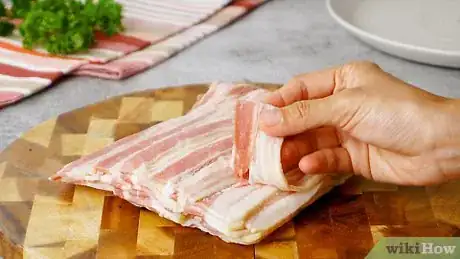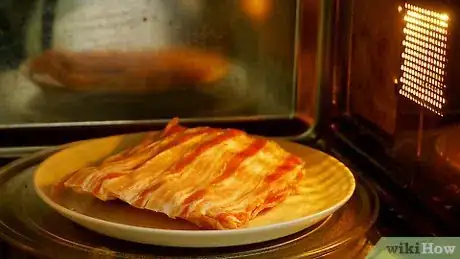This article was co-authored by Ed Kuoha. Ed Kuoha is a Chef and the Owner of Kuoha Culinary based in Aiea, Hawaii. He has more than 20 years of experience in various culinary kitchens and settings such as Morimoto Waikiki, where he received hands-on training from Iron Chef Morimoto. Chef Ed specializes in small catering events and private chef requests. He holds an Associate’s degree from The Culinary Institute of the Pacific at Kapiolani Community College.
This article has been viewed 818,154 times.
With its crisp, deliciously savory flavor, bacon is a treat for breakfast or any other meal of the day. Luckily, bacon that's been stored frozen isn't hard to prepare. With a few minor changes, it can be cooked almost exactly like it would normally. See our main article on cooking bacon for additional help.
- Prep time: 5 minutes
- Cook time: 5-10 minutes
- Total time: 10-15 minutes
Steps
Cooking from Frozen
-
1See if you can separate the bacon into slices. When frozen, bacon can more or less be cooked in the same ways as when it isn't frozen: frying, baking, microwaving, etc. There is just one major difference: if the frozen bacon slices are stuck together, you need to separate them first.[1]
- If you froze the slices separately or you can pry them apart easily, you're set. Simply cook the bacon as you normally would, allowing a little extra cooking time to compensate for the fact that they are frozen. Some meats take an extra 50% of their original cooking time to cook from frozen, but bacon slices are so thin that they'll usually only take an extra minute or two at most.
-
2If you can't separate the slices, heat the block on low. Often, if you freeze a package of bacon, it will form a large solid block that can't easily be broken into individual slices. This is OK — you can still cook your bacon fairly quickly. Start by cooking the entire block with low heat to loosen up the slices. There are a few ways to do this:
- The easiest is generally to put the frozen block into a frying pan and heat it over a burner set to "low." Turn it frequently to ensure even cooking.
- You can also put the block on a paper towel-lined plate and use your microwave's "defrost" setting.
- Don't use the oven to loosen up a block of frozen bacon. It's usually too much trouble to constantly transfer it in and out as you check it for doneness.
Advertisement -
3Peel pieces off as they loosen. The low heat will quickly start to soften the outer layers of the bacon block. As they soften, they'll become much easier to remove. Peel the individual pieces of bacon off as soon as you can do so. Lay them next to the block or in a separate dish.
- Use a set of tongs or another utensil here. You're using low heat, but it can still be enough to burn you.
-
4Cook the separated pieces as normal. Once all the pieces are separated, they should be most of the way (if not completely) thawed, so you can cook them as normal. [2] Our guide to cooking bacon has detailed instructions on how to do this. In broad strokes, you should:
- Turn the heat up to medium-low or medium. If you removed the bacon from the pan while it was defrosting, transfer it back in.
- Let the bacon cook until it starts sizzling. At this point, start turning the slices every few minutes to ensure even cooking.
- When the bacon is well-browned and reaches your desired level of done-ness, transfer it to a paper towel-lined plate. You're done!
Thawing Before Cooking
While most bacon can be cooked from frozen, you can also thaw it first and then cook it normally. This may be preferable if you are more comfortable working with defrosted bacon. In this section, a few easy thawing methods are suggested.
-
1Thaw in the refrigerator. This is generally the cleanest way to thaw a package of bacon. Simply put it in the fridge in its original container and wait for it to thaw to a uniformly soft texture. This can take anywhere from a couple hours to a day or more depending on your refrigerator's temperature.
- This method of thawing generally leaves the bacon usable for the longest amount of time — it's almost as if you transferred fresh bacon directly into the fridge. You can cook or refreeze the bacon within seven days.
- For loose slices of bacon, place them inside a sealed plastic bag or container before defrosting. This can help prevent the dehydrating effects of cool refrigerator air.
-
2Thaw in cold water. Fill your sink with cold water from the faucet. Drop the package of bacon into the water and let it sit. If it floats, weigh it down with a heavy pan or plate. Smaller packages will take 10-15 minutes to fully thaw. Larger packages may take up to an hour. If it takes longer than 30 minutes, dump the water and refill again with cold water.
- Don't use warm or hot water. This will make the outside of the bacon warm quicker than the inside, ruining its texture and potentially causing dangerous bacteria growth.
- If you're not thawing the bacon in its original package, make sure you seal it in an airtight bag. You don't want the bacon to come into direct contact with the water — this can be unsanitary and may affect the bacon's taste or texture.
-
3Defrost in the microwave. Place the bacon on a paper towel-lined plate and defrost it for three minute intervals, checking its texture between each defrosting. Separate the bacon as it defrosts to speed up the process.
- You can leave the bacon in its original package, but if you do, poke a few holes in the package to allow it to vent. If you don't, steam can build up and cause an explosion.
-
4Cook thawed bacon normally. Once the bacon is completely thawed, you're ready to start cooking. Transfer it to a frying pan (or another vessel if you're using a different cooking method like baking) and cook it as you normally would.
- Be sure to wash your hands after handling defrosted bacon. Warming uncooked bacon to luke-warm heat (like most defrosting methods do) makes it a prime breeding ground for bacteria.
- Most thawed bacon should be cooked fairly quickly to avoid bacterial contamination. The exception is bacon thawed in the fridge — since it's kept cool, it's generally safer to store.
Community Q&A
-
QuestionAfter freezing my bacon, it seems to release a lot of water when cooking. Why is this?
 Community AnswerBecause you are evaporating the water that has melted from ice. The water that was in the bacon froze, and when you cook it, it melts that ice, and then turns the water to steam.
Community AnswerBecause you are evaporating the water that has melted from ice. The water that was in the bacon froze, and when you cook it, it melts that ice, and then turns the water to steam. -
QuestionI froze bacon wrapped scallops, how do I thaw them quickly?
 Community AnswerPut them in a bowl with hot water, place them over a warm vent, and cover with a towel until there are thawed.
Community AnswerPut them in a bowl with hot water, place them over a warm vent, and cover with a towel until there are thawed. -
QuestionCan you defrost 2.5kg frozen solid bacon in the oven? For how long and in what temperature?
 Brandon SalazarCommunity AnswerLeave it in the fridge the night before and it should be thawed when you go to cook it.
Brandon SalazarCommunity AnswerLeave it in the fridge the night before and it should be thawed when you go to cook it.
Warnings
- When thawing bacon in cold water, do not let it get exposed to air or water. If the package is not airtight, the bacon can be exposed to bacteria from the air. It can also absorb water.⧼thumbs_response⧽
References
About This Article
Before cooking frozen bacon, try to separate the pieces. If you can’t pry them apart easily, put the block of frozen slices in a skillet and warm them over low heat until they’re soft enough to pull apart. You can also try defrosting them in the microwave on a plate lined with paper towels. Once you’re able to separate the slices of bacon, cook them as you normally would. While there are lots of ways to cook bacon, the most common method is to lay out the strips in a single layer in a skillet and cook them over medium heat. Once the bacon starts to sizzle, turn the slices over every few minutes until they reach your desired level of crispiness. If you’d rather defrost the bacon ahead of time, transfer it to the fridge and leave it overnight to thaw. If you’re in more of a hurry, place the sealed package of bacon in a container of cold water on your counter. This method may take as little as 15 minutes, but change the water every 30 minutes if it takes longer. You can also microwave the bacon on the defrost setting at 3-minute intervals until it is completely thawed.


















































